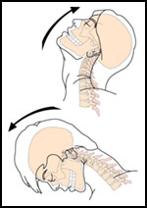

|
· Features: · Most common cause is due to motor vehicle accident (MVA) - rear end collision being the most common type · Sudden Acceleration Deceleration Injury to the Spine · Symptom onset can be immediate but usually up to hours or even days after initial event · Stretching and shearing injury to ligaments muscles and joint complexes (facets and intervertebral disc) and even nerves in the cervical spine · Pain onset associated with onset of acute inflammation |
|
Cervical Whiplash Injury occurs as a result of sudden jerking type motion to the cervical spine and cervicothoracic junction. As a result ligaments, muscles, tendons, joint capsules and other soft tissue structures, and possibly even more seriously, the intervertebral disc and nerves are stretched and sheared beyond their physiological limit. Often the injury is as a result of protective muscle spasm acting to try to protect the neck area working against the distractive force thus resulting in more severe muscular sprain injuries. In around 50% of cases symptoms will significantly or completely resolve during the first 4 weeks after injury. In around 25% of cases there may still be some pain and stiffness at half a year after injury. Whiplash syndrome occurs when pain becomes persist long after the initial injury. In cases of severe whiplash injury with clinical neck instability or fracture, surgery may be indicated.
GRADING OF INJURY Quebec Whiplash Classification: Grade 1: complaints of neck pain, stiffness or tenderness only but no physical signs are noted by the examining physician. Grade 2: neck complaints and the examining physician finds decreased range of motion and point tenderness in the neck. Grade 3: decreased range of motion plus neurological signs such as decreased deep tendon reflexes, weakness, insomnia and sensory deficits. Grade 4: neck complaints and fracture or dislocation, or injury to the spinal cord.
TREATMENT In the initial phase this consists of measures to reduce acute inflammation and ease muscle spasm. This will typically include oral anti inflammatory medications such as diclofenac, ibuprofen and similar medications. Muscle relaxants may be prescribed. Physical therapy can have its role at all stages of rehabilitation, in the acute phase to reduce inflammation and ease muscle spasm utilizing modalities such as electrical stimulation and at a later stage gentle mobilization exercises to reduce stiffness and to regain motion. |
|
WHIPLASH INJURY |

|
Copyright © 2008 Spine Care Hong Kong |


|
SPINE CARE HONG KONG |
|
ACCURATE DIAGNOSIS, STRUCTURED TREATMENT |
